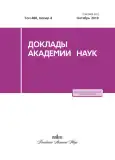The interaction effect of bacterial cellulose with gold nanoparticles obtained by metal-vapor synthesis
- Authors: Rubina M.S.1, Pigaleva M.A.1,2, Butenko I.E.1,3, Budnikov A.V.1, Naumkin A.V.1, Gromovykh T.I.3, Lutsenko S.V.3, Vasil’kov A.Y.1
-
Affiliations:
- Institute of Organoelement Compounds of the Russian Academy of Sciences
- Lomonosov Moscow State University
- The First Sechenov Moscow State Medical University under Ministry of Health of the Russian Federation
- Issue: Vol 488, No 4 (2019)
- Pages: 391-396
- Section: Physical chemistry
- URL: https://journals.eco-vector.com/0869-5652/article/view/17680
- DOI: https://doi.org/10.31857/S0869-56524884391-396
- ID: 17680
Cite item
Abstract
In the present work, a promising method was proposed for the formation of new functional nanocomposite materials based on bacterial cellulose and Au nanoparticles obtained by a biocompatible and environmentally friendly metal vapor synthesis. The structure and composition of the composite films surface were studied by XPS, SEM, and IR spectroscopy. It was determined that Au nanoparticles effectively chemisorb the bacterial cellulose nanofibrils forming nanoparticles with a size of about 25 nm with a “metal core-hydrocarbon shell” structure.
About the authors
M. S. Rubina
Institute of Organoelement Compounds of the Russian Academy of Sciences
Author for correspondence.
Email: margorubina@yandex.ru
Russian Federation, 28, Vavilova street, Moscow, 119991
M. A. Pigaleva
Institute of Organoelement Compounds of the Russian Academy of Sciences; Lomonosov Moscow State University
Email: pigaleva@polly.phys.msu.ru
Russian Federation, 28, Vavilova street, Moscow, 119991; 1, Leninskie gory, Moscow, 119991
I. E. Butenko
Institute of Organoelement Compounds of the Russian Academy of Sciences; The First Sechenov Moscow State Medical University under Ministry of Health of the Russian Federation
Email: margorubina@yandex.ru
Russian Federation, 28, Vavilova street, Moscow, 119991; 8-2, Trubetskaya street, Moscow, 119992
A. V. Budnikov
Institute of Organoelement Compounds of the Russian Academy of Sciences
Email: margorubina@yandex.ru
Russian Federation, 28, Vavilova street, Moscow, 119991
A. V. Naumkin
Institute of Organoelement Compounds of the Russian Academy of Sciences
Email: margorubina@yandex.ru
Russian Federation, 28, Vavilova street, Moscow, 119991
T. I. Gromovykh
The First Sechenov Moscow State Medical University under Ministry of Health of the Russian Federation
Email: margorubina@yandex.ru
Russian Federation, 8-2, Trubetskaya street, Moscow, 119992
S. V. Lutsenko
The First Sechenov Moscow State Medical University under Ministry of Health of the Russian Federation
Email: margorubina@yandex.ru
Russian Federation, 8-2, Trubetskaya street, Moscow, 119992
A. Yu. Vasil’kov
Institute of Organoelement Compounds of the Russian Academy of Sciences
Email: margorubina@yandex.ru
Russian Federation, 28, Vavilova street, Moscow, 119991
References
- Moniri M., Moghaddam A.B., Azizi S., et.al. Production and Status of Bacterial Cellulose in Biomedical Engineering // Nanomaterials. 2017. V. 7. P. 257. doi: 10.3390/nano7090257
- Shamaila S., Zafar N., Riaz S., et.al. Gold Nanoparticles: an Efficient Antimicrobial Agent Against Enteric Bacterial Human Pathogen // Nanomaterials. 2016. V. 6. P. 71. doi: 10.3390/nano6040071
- Shah N., Ul-Islama M., Khattaka W. A., et.al. Overview of Bacterial Cellulose Composites: A Multipurpose Advanced Material // Carbohydrate Polymers. 2013. V. 98. P. 1585-1598. doi: 10.1016/j.carbpol.2013.08.018
- Li G., Sun K., Li D., et.al. Biosensor Based on Bacterial Cellulose-Au Nanoparticles Electrode Modified with Laccase for Hydroquinone Detection // Colloids and Surfaces. A: Physicochem. Eng. Aspects. 2016. V. 509, P. 408-414. doi: 10.1016/j.colsurfa.2016.09.028
- Wei H., Rodriguez K., Renneckar S., et.al. Preparation and Evaluation of Nanocellulose-Gold Nanoparticle Nanocomposites for SERS Applications // Analyst. 2015. V. 140. P. 5640. doi: 10.1039/c5an00606f
- Cárdenas-Triviño G., Elgueta C., Vergara L., et.al. Chitosan Doped with Nanoparticles of Copper, Nickel and Cobalt // International Journal of Biological Macromolecules. 2017. V. 104A. P. 1-24. doi: 10.1016/j.ijbiomac.2017.06.040
- Abd-Elsalam K.A., Vasil’kov A.Yu., Said-Galiev E.E., et.al. Bimetallic Blends and Chitosan Nanocomposites: Novel Antifungal Agents Against Cotton Seedling Damping-off // Eur. J. Plant Pathol. 2018. V. 151. P. 57-72. doi: 10.1007/s10658-017-1349-8
- Патент РФ. 2011. № 2415221. Штамм бактерии Gluconacetobacter hansenii GH-1/2008 - продуцент бактериальной целлюлозы. Авторы Громовых Т.И., Фан Ми Хань, Данильчук Т.Н. № 2464307. Заявка № 2011121841. Опубл. 20.10.2012. Бюлл. № 29.
- Schramm M., Gromet Z., Hestrin S. Synthesis of Cellulose by Acetobacter Xylinum. 3. Substrates and Inhibitors // Biochem J. 1957. V. 67 (4). Р. 669-679. doi: 10.1042/bj0670669
- Vasil’kov A.Yu, Rubina M.S., Gallyamova A.A., et.al. Mesoporic Material from Microcrystalline Cellulose with Gold Nanoparticles: a New Apporoach to Metal-carrying Polysaccharides // Mend. Commun. 2015. V. 25(5). P. 358-360, doi: 10.1016/j.mencom.2015.09.014
- Beamson G. and Briggs D. High Resolution XPS of Organic Polymers. Chichester: Wiley, 1992.
- Vasil’kov A.Y., Naumkin A.V., Volkov I.O., Podshibikhin V.L., Lisichkin G. V., Khokhlov A.R. XPS/TEM Characterisation of Pt-Au/C Cathode Electrocatalysts Prepared by Metal Vapour Synthesis // Surf. Int. Anal. 2010. V. 42. P. 559-563. doi: 10.1002/sia.3269
- Качала В., Хемчян Л., Кашин А. и др. Комплексное исследование структуры и механизмов получения и превращений газообразных, жидких и твердых химических систем методами масс-спектрометрии, спектроскопии ЯМР и электронной микроскопии // Успехи химии. 2013. Т. 82. С. 648-685. DOI: 10.1070/ RC2013v082n07ABEH004413
- Široký J., Blackburn R.S., Bechtold T., et.al. Attenuated Total Reflectance Fourier-Transform Infrared Spectroscopy Analysis of Crystallinity Changes in Lyocell Following Continuous Treatment with Sodium Hydroxide // Cellulose. 2010. V. 17. P. 103-115. doi: 10.1007/s10570-009-9378-x
- Schwanninger M., Rodrigues J.C., Pereira H., et.al. Effects of Short-Time Vibratory Ball Milling on the Shape of FT-IR Spectra of Wood and Cellulose // Vib. Spectrosc. 2004. V. 36. P. 23-40. doi: 10.1016/j.vibspec.2004.02.003
Supplementary files








